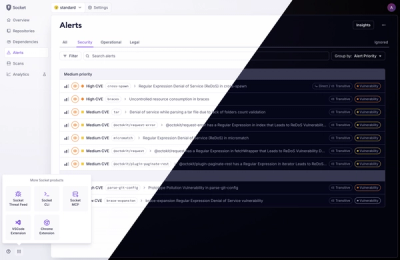
Product
A Fresh Look for the Socket Dashboard
We’ve redesigned the Socket dashboard with simpler navigation, less visual clutter, and a cleaner UI that highlights what really matters.

Empower your CrewAI agents with powerful, customizable tools to elevate their capabilities and tackle sophisticated, real-world tasks.
CrewAI Tools provide the essential functionality to extend your agents, helping you rapidly enhance your automations with reliable, ready-to-use tools or custom-built solutions tailored precisely to your needs.
Homepage | Documentation | Examples | Community
CrewAI provides an extensive collection of powerful tools ready to enhance your agents:
FileReadTool, FileWriteToolScrapeWebsiteTool, SeleniumScrapingToolPGSearchTool, MySQLSearchToolSerperApiTool, EXASearchToolDallETool, VisionTool, StagehandToolAnd many more robust tools to simplify your agent integrations.
CrewAI offers two straightforward approaches to creating custom tools:
BaseToolDefine your tool by subclassing:
from crewai.tools import BaseTool
class MyCustomTool(BaseTool):
name: str = "Tool Name"
description: str = "Detailed description here."
def _run(self, *args, **kwargs):
# Your tool logic here
tool DecoratorQuickly create lightweight tools using decorators:
from crewai import tool
@tool("Tool Name")
def my_custom_function(input):
# Tool logic here
return output
CrewAI Tools supports the Model Context Protocol (MCP). It gives you access to thousands of tools from the hundreds of MCP servers out there built by the community.
Before you start using MCP with CrewAI tools, you need to install the mcp extra dependencies:
pip install crewai-tools[mcp]
# or
uv add crewai-tools --extra mcp
To quickly get started with MCP in CrewAI you have 2 options:
In this scenario we use a contextmanager (with statement) to start and stop the the connection with the MCP server.
This is done in the background and you only get to interact with the CrewAI tools corresponding to the MCP server's tools.
For an STDIO based MCP server:
from mcp import StdioServerParameters
from crewai_tools import MCPServerAdapter
serverparams = StdioServerParameters(
command="uvx",
args=["--quiet", "pubmedmcp@0.1.3"],
env={"UV_PYTHON": "3.12", **os.environ},
)
with MCPServerAdapter(serverparams) as tools:
# tools is now a list of CrewAI Tools matching 1:1 with the MCP server's tools
agent = Agent(..., tools=tools)
task = Task(...)
crew = Crew(..., agents=[agent], tasks=[task])
crew.kickoff(...)
For an SSE based MCP server:
serverparams = {"url": "http://localhost:8000/sse"}
with MCPServerAdapter(serverparams) as tools:
# tools is now a list of CrewAI Tools matching 1:1 with the MCP server's tools
agent = Agent(..., tools=tools)
task = Task(...)
crew = Crew(..., agents=[agent], tasks=[task])
crew.kickoff(...)
If you need more control over the MCP connection, you can instanciate the MCPServerAdapter into an mcp_server_adapter object which can be used to manage the connection with the MCP server and access the available tools.
important: in this case you need to call mcp_server_adapter.stop() to make sure the connection is correctly stopped. We recommend that you use a try ... finally block run to make sure the .stop() is called even in case of errors.
Here is the same example for an STDIO MCP Server:
from mcp import StdioServerParameters
from crewai_tools import MCPServerAdapter
serverparams = StdioServerParameters(
command="uvx",
args=["--quiet", "pubmedmcp@0.1.3"],
env={"UV_PYTHON": "3.12", **os.environ},
)
try:
mcp_server_adapter = MCPServerAdapter(serverparams)
tools = mcp_server_adapter.tools
# tools is now a list of CrewAI Tools matching 1:1 with the MCP server's tools
agent = Agent(..., tools=tools)
task = Task(...)
crew = Crew(..., agents=[agent], tasks=[task])
crew.kickoff(...)
# ** important ** don't forget to stop the connection
finally:
mcp_server_adapter.stop()
And finally the same thing but for an SSE MCP Server:
from mcp import StdioServerParameters
from crewai_tools import MCPServerAdapter
serverparams = {"url": "http://localhost:8000/sse"}
try:
mcp_server_adapter = MCPServerAdapter(serverparams)
tools = mcp_server_adapter.tools
# tools is now a list of CrewAI Tools matching 1:1 with the MCP server's tools
agent = Agent(..., tools=tools)
task = Task(...)
crew = Crew(..., agents=[agent], tasks=[task])
crew.kickoff(...)
# ** important ** don't forget to stop the connection
finally:
mcp_server_adapter.stop()
Always make sure that you trust the MCP Server before using it. Using an STDIO server will execute code on your machine. Using SSE is still not a silver bullet with many injection possible into your application from a malicious MCP server.
.content[0].textWe welcome contributions from the community!
git checkout -b feature/my-feature).git commit -m 'Add my feature').git push origin feature/my-feature).pip install crewai[tools]
uv syncuv run pytestuv run pyrightpre-commit installJoin our rapidly growing community and receive real-time support:
Build smarter, faster, and more powerful AI solutions—powered by CrewAI Tools.
FAQs
Set of tools for the crewAI framework
We found that crewai-tools demonstrated a healthy version release cadence and project activity because the last version was released less than a year ago. It has 2 open source maintainers collaborating on the project.
Did you know?

Socket for GitHub automatically highlights issues in each pull request and monitors the health of all your open source dependencies. Discover the contents of your packages and block harmful activity before you install or update your dependencies.

Product
We’ve redesigned the Socket dashboard with simpler navigation, less visual clutter, and a cleaner UI that highlights what really matters.

Industry Insights
Terry O’Daniel, Head of Security at Amplitude, shares insights on building high-impact security teams, aligning with engineering, and why AI gives defenders a fighting chance.

Security News
MCP spec updated with structured tool output, stronger OAuth 2.1 security, resource indicators, and protocol cleanups for safer, more reliable AI workflows.